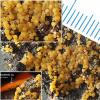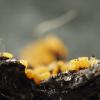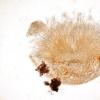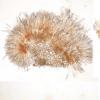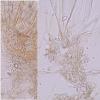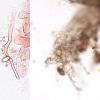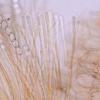
06-12-2025 00:19
 Viktorie Halasu
Viktorie Halasu
Hello, would anyone have this article, please? An

05-12-2025 17:33
 Bruno Coué
Bruno Coué
Bonjour, je serais heureux de recueillir votre avi

02-12-2025 18:59
This pair of ascos 2.5cm across were on recently b

02-12-2025 19:25
Buckwheat PeteHello, can anyone identify this hairy fungus growi

30-11-2025 12:53
 Edvin Johannesen
Edvin Johannesen
White short-stipitate apothecia found on thin twig

30-11-2025 10:47
 William Slosse
William Slosse
I recently found a collection of small Peziza sp.
 Dear members of this forum
Dear members of this forumCould this find be Cheilymenia crassistriata or a form of Ch. granulata?
This find have very small apothecia, a yellow color and does not contain hairs or capitate paraphyses.
Thanks for your advice.
On moist soil (dung?)
Apothecia: small; 0.3-0.7 (1) mm, subcylindrical; turbinate or barrel-shaped; hymenium yellow to ocher yellow,; hymenium with protruding asci; see also the picture with the difference in color between this find and the orange red color of a Scutellinia sp.
Medullar excipulum: 10-20 diam.; differentiated with smaller cells, textura angularis to textura subintricata/subepidermoidea; none hyphal elements observed, none cyanophilic septa observed.
Ectal excipulum: 24-50 x 20-41 µm textura subglobose to angularis
Marginal hairs: none observed
Lateral hairs: none observed;
Hyphoid hairs: only hyphal outgrowth at the base, : 5-6µm in diam. , thin to slightly thick walled, originating from the outermost excipular cells; eight apothecia has been checked for the presence/absence of hairs.
Spores: (14.1) 14.9 - 16.4 (16.7) × (8.3) 8.4 - 9.6 (10.1) µm; Q = (1.5) 1.6 - 1.8 (1.9) ; N = 26; Me = 15.6 × 9.1 µm ; Qe = 1.7, weakly striation was already seen in water; striation in cotton blue distinct, irregular (in space and thickness), ribs 0.25-0.55 (0.7) µm wide; the epispore seems to be very loosely around the spore, one nucleus
Asci 8-sp, with croziers, 175-220 x 10-14 µm
Paraphyses: septate, 3-4.5 µm diam., non-enlarged to gradually slightly enlarged, 7-8 µm; with orange granular pigment ,top cell paler, rarely branched.

Yes, I think your determination is correct; it is a species which I believe is not common.
Michel.

